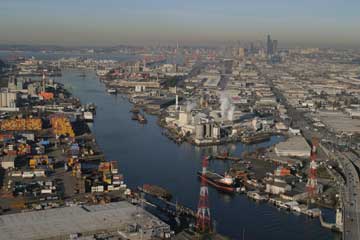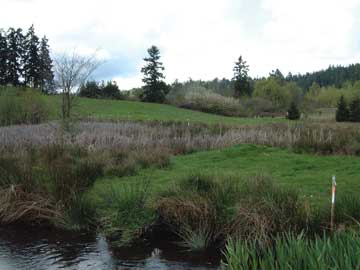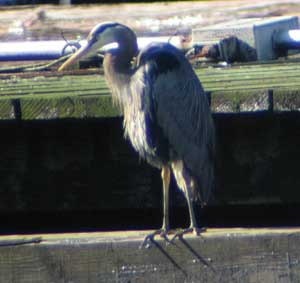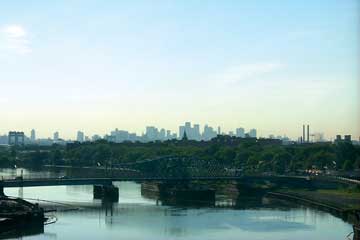|
FEATURE
Urban Wetland Restoration: Creating Room to Grow
Jenny Buening, Kathleen Hurley, Mike Johns
 King County photo by Ned Ahrens |
| Ninety-eight percent of the wetlands and marshlands that once filled the Duwamish River estuarine delta in Seattle, Wash., has been eliminated over a century-long process of converting the delta into a channeled waterway. Portions of the waterway are the focus of urban restoration efforts to return parts of this historical ecosystem to salmon, birds and other wildlife. |
While walking in a large city, one may encounter fish and wildlife, remnants of the city’s past, in unusual places. Instead of cliffs or tree hollows, peregrine falcons now nest on skyscrapers and bridges in New York City. A few salmon and steelhead trout still return to streams in San Francisco. A great blue heron nesting colony can be found near the developed shores of Seattle’s Ship Canal. These are just a few examples of urban wildlife that continue to survive and adapt in cities throughout the country.
These species, though adaptable, depend on small pockets of tranquil habitat that remain within the urban setting, such as parks, backyards and, in more recent times, urban restoration sites.
Habitat loss is one of the leading causes of the overall decline in plant and animal populations. More than 1,300 species are listed as threatened or endangered under the Endangered Species Act. Species loss is often greatest in the most highly developed areas, such as urban centers and their surrounding suburbs. Despite significant habitat loss and reduced biodiversity in cities, however, many wildlife species persist, thanks in part to these new urban restoration efforts.
Such efforts are growing nationwide in both private and public arenas. With increasing awareness about global climate change, people are beginning to recognize the important role the natural world plays in their daily lives. With that awareness comes a renewed sense of responsibility and the desire to improve habitat.
Wetlands
As defined by the Clean Water Act, wetlands are areas that are inundated or saturated by surface water or groundwater at a frequency and duration sufficient to support vegetation that is typically adapted for life in saturated soil conditions. The August 2005 Hurricane Katrina strike on the U.S. Gulf Coast brought the importance of wetlands to the attention of the American people. In assessing the effects of the storm, scientists relayed how some of Katrina’s impact could have been lessened if the extensive Gulf Coast wetlands had not been so altered. Today, wetlands are recognized as providing critical habitats for a variety of sensitive species in addition to numerous other benefits, such as storm surge protection. Thus, wetland environments are the focus of many restoration projects.
 Windward Environmental LLC |
| Urban wetlands, such as above in King County, Wash., provide herons and other wildlife a refuge in cities and suburbs. They also provide people with the chance to interact with such wildlife. |
Wetlands often serve as transitional zones between upland areas and aquatic environments such as lakes, rivers or streams; however, they can also exist as isolated pockets in forests, fields and urban areas. Wetlands serve as breeding grounds, foraging areas or migration corridors for a variety of invertebrate, fish, amphibian, bird and mammal species. Wetland vegetation in riparian and shoreline areas creates shade to help keep water cool and is used as cover by birds, fish and other aquatic species. Woody debris such as snags and downed trees are common in wetlands and provide shelter and nesting areas for birds and mammals.
As a transitional ecosystem, wetlands serve a variety of functions. They play a key role in hydrologic processes, feeding lakes and streams, recharging groundwater aquifers and providing stormwater retention and erosion control. During heavy precipitation events, wetlands help to control flooding and can retain up to 1.5 million gallons of water per acre, according to the U.S. Environmental Protection Agency (EPA), releasing it slowly over time to connected aquatic systems such as lakes and streams. The natural ability of wetlands to reduce flooding helps protect the integrity of habitat structures in aquatic environments, such as fish spawning beds, which are often washed away by fast-moving storm flow.
 Jason Love |
| A great blue heron, perched at the Hiram M. Chittenden Locks in Seattle, Wash., keeps a watchful eye for salmon fingerlings and other small fish present in the canal below. |
Wetlands also serve an important function in the cycling and storage of nutrients such as nitrogen, carbon, sulfur, iron and manganese, converting them into forms that can be absorbed through plant roots and making them available to other organisms higher up the food chain. Wetlands also improve water quality. Soils and plants in wetlands provide natural filtration, removing contaminants from surface water and groundwater. Chemicals such as chlorinated compounds and hydrocarbons can be removed naturally in wetland systems through absorption, degradation or volatilization.
Historical Losses
Despite the ecological functions and benefits that wetlands provide, the United States has seen extensive losses of wetland acreage over the past 400 years. According to the EPA, approximately half of the 890,000 square kilometers (220 million acres) of wetlands that existed in the contiguous United States in the early 1600s has been lost as a direct result of human activity or intervention. Agriculture, urbanization, logging and mining have driven this loss.
Early losses were primarily associated with the drainage and reclamation of land for agricultural purposes. Settlers believed that wetlands created “swamp vapors” and caused fevers and illness because they provided breeding grounds for mosquitoes, vectors of malaria and dengue fever; therefore, wetland drainage was encouraged. Settlers drained much of the land in Virginia and the Carolinas, for example. Later, as industrialization consolidated populations into urban centers, such as in Chicago and Miami, wetlands were drained to increase the land available for development. Lands along rivers and bays within developing cities were desirable locations for manufacturing and processing operations because they provided easy access to open water, which was essential for transporting goods. It was against this backdrop that “wetlands” became synonymous with “wastelands” — land that needed to be converted to a useful purpose.
As a result, many urban waterways have been engineered to make them more suitable for industrial, commercial and transportation activities, leading to an almost complete wetland loss in many urban areas. The dramatic reduction in wetland acreage nationwide has translated into losses of important habitat areas and other wetland benefits, as evidenced by declining fish and wildlife populations, increased flooding during storm events and declining water quality in rivers, lakes and bays.
Wetlands Protection and Mitigation
Today, the primary pressure on wetlands is from urban development. The public perception of the value of wetlands is changing, however, and with laws now designed to protect wetlands, the rate of loss is diminishing. According to the U.S. Fish and Wildlife Service, wetland loss has fallen from a peak annual rate of 1,853 square kilometers (458,000 acres) per year in the mid-1950s to 237 square kilometers (58,500 acres) per year in 1997. This great reduction in wetland loss can be directly attributed to the implementation of the Clean Water Act in the 1970s, legislation designed to protect wetlands and acknowledge their ecological and practical functions.
Under the Clean Water Act, the protection of remaining wetlands is handled through federal, state and local regulations designed to prevent further losses and mitigate for unavoidable damages to wetlands. Individual states build on the federal policies and often implement additional regulations that are more stringent than federal policies. Local jurisdictions, such as counties and cities, can also enforce wetlands regulations through their authority over land-use management.
| The New York/New Jersey estuary complex, of which the Passaic River is part, has lost 80 percent of its wetlands. Parts of the river have been restored to allow habitat for birds and other wildlife as well as to enable more human use for recreation. |
A major component of federal wetlands regulations is mitigation, whereby proposed projects must first attempt to avoid and minimize their impact on wetlands, and any unavoidable impact must be addressed during the permitting process (see sidebar). Permitted wetland losses must be offset through mitigation efforts. Parties applying for wetland permits must demonstrate that they have made every practicable attempt to avoid wetland impacts before mitigation will be considered.
Since the implementation of the Clean Water Act and wetlands mitigation practices, mitigation has generally focused on the property where the proposed impact will occur, adhering to the practice of keeping the mitigation activities onsite. Furthermore, federal guidelines generally call for “in-kind” mitigation, meaning that the newly created or restored wetland be of the same class or type — generally based on position in the landscape, water regime and vegetation type — as the original, affected wetland. Though well-intentioned, in many instances, these mitigation policies lead to the creation of small, low-functioning wetlands, stifled by poor hydrology, invasive species infestations or other factors. According to the Interstate Technology and Regulatory Council, only 30 to 50 percent of wetland mitigation projects are considered successful. Thus, these mitigation projects often fail to meet their goals of replacing the acreage and functions lost when the original wetland was affected. All is not lost, however, as urban restoration is on the rise and is beginning to help create and restore wetland habitats within urban areas.
Urban habitats
Habitat restoration in cities offers benefits for the entire ecosystem, including plants, animals and people. Even small restored wetlands areas in urban settings, such as the River Fringe wetlands on the Anacostia River in Washington, D.C., can provide critical habitat islands for birds, amphibians and small mammals. And linking restoration areas through proximity or by corridors, such as “interurban” trails or reclaimed railway lines, can provide travel routes for a variety of permanent and migratory species. For example, in Florida, land was purchased to create the Florida Ecological Network and provide essential wildlife corridors to protect Florida panthers and black bears.
Moreover, the presence of urban wetlands offers opportunities for people to learn about and enjoy natural areas close to home, which elevates the social value placed on them. After walking along Whatcom Creek in Bellingham, Wash., for example, and seeing salmon swim up the stream, people become aware of the other species that share their home.
Efforts to restore wetlands in urban areas around the country are on the rise. For example, the Duwamish River in Seattle, Wash., is a wetlands ecosystem that was altered to accommodate shipping in the early 1900s. Located on Puget Sound, the Lower Duwamish Waterway once comprised hundreds of acres of wetlands and marsh habitat. To better serve the needs of a growing city, the river channel was straightened and dredged, and the surrounding wetlands area was drained and filled, eliminating 98 percent of the existing tidal flats, marshes and swamps.
The Passaic River in New Jersey faced a similar situation. According to the Hudson River Foundation, 80 percent of the New York/New Jersey estuary complex, of which the Passaic River is part, has been filled in or dredged for urban and industrial purposes.
Current plans and efforts to restore both of these areas are focusing on creating intertidal, estuarine and other wetlands habitats that will benefit resident and migratory fish, birds and terrestrial wildlife. For example, the Hamm Creek Estuary Restoration Project, a collaborative effort between public and private groups, was initiated to restore this tributary of the Duwamish Estuary. The project restored part of the salt marsh, freshwater wetlands and stream channel, returning one portion of this historical river system to salmon, birds and other wildlife. In the New York/New Jersey Harbor system, the Harbor Estuary Program has identified impacted wetlands areas in eight watersheds for restoration.
Wetland restoration efforts will play an important role in the survival and recovery of wildlife in urban areas. These efforts have to involve both cooperation and collaboration of stakeholders, including local governments, private landowners, scientists and the local community. Each piece of urban habitat connected to another, like pearls on a string, creates critical sanctuary for the peregrine falcon, salmon, trout, the great blue heron, and every other species trying to survive in our nation’s cities and suburbs.
|
Mitigation — the process of replacing wetlands to make up for those lost by development projects — is a major component of federal wetlands regulations. Proposed development projects must first attempt to avoid and minimize their impact on wetlands, and any unavoidable impact must be addressed during the permitting process. There are several types of wetland mitigation; however, standard practices often result in small, poorly maintained wetlands that do not function as well as the original wetlands. Recent scientific guidance by organizations such as the National Academy of Sciences National Research Council is changing the opinions of some wetland regulators and mitigation practitioners on how best to create successful mitigation projects. In recent years, the U.S. Army Corps of Engineers and the U.S. Environmental Protection Agency have started to encourage a landscape- or watershed-based approach to the management of wetlands. This means that instead of wetlands impacts always having to be mitigated on the same property where the impact occurred, parties with mitigation responsibilities can consider looking at other nearby areas as places to satisfy their mitigation needs when onsite options are limited or would produce unsustainable or low-functioning wetlands. This flexibility can be beneficial for people and also for wetland habitats. When the watershed-based approach is used, areas most likely to produce high-functioning and self-sustaining wetlands can be selected as mitigation project sites. Through wetland mitigation banks, the resources of many smaller mitigation projects are, in a sense, pooled into a larger project. Wetland mitigation bank sites often provide habitat areas with greater ecological value than those associated with smaller individual projects, and their success can be more easily monitored by the regulatory agencies that require them. A wetland banker restores wetlands to earn “credits” from the appropriate regulatory bodies. The larger and more productive the wetland, the more credits the banker can earn. The banker can store these credits for his or her own mitigation needs or sell them to other entities required to perform mitigation. This drives wetland bankers to select sites that will produce viable habitat in strategic locations, such as within habitat corridors and along streams and other water bodies, in order to earn more credits. Last year, the first urban wetland bank was certified in Washington. The Springbrook Creek bank is located in Renton, Wash., a rapidly growing city. In total, the bank contains roughly 421,000 square meters (104 acres) of depressional and riverine wetlands, all located in an urban setting. Great blue herons nest on an adjacent property and forage at the bank site regularly, and trout and salmon have been spotted in the adjacent Springbrook Creek. Credits generated by the bank will be used by the Washington State Department of Transportation and the City of Renton to satisfy their mitigation responsibilities for wetland impacts at nearby project sites. |
.
Links:
Hazecam.net
www.windwardenv.com

 Subscribe
Subscribe



